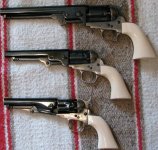Make your own felt wads.
Buy sheet felt of 1/8" thickness from Durofelt at
http://www.durofelt.com/
Buy the Hard felt. Durofelt is made of 100% wool. Much of today's felt is limp and polyester (plastic) that may leave tiny nodules of melted plastic in the bore.
Check the clearance section in Durofelt for good buys on hard sheet felt.
A 3/8" hole punch will make wads for .36 caliber, a 5/16" for .31 caliber.
The 7/16" punch is a little small for .44 cap and balls, which are closer to .45 caliber, but is useful for making wads for cartridges such as .44/40, .44 Special, .44 Magnum or .444 Marlin.
Buy a .45 caliber punch from Buffalo Arms.
Punch the wads against the end grain of a small log, or against a hard plastic cutting board. Cutting boards are often found for a buck or two at thrift stores.
Melt the lubricant at low temperature and soak the wads in it. The Altoids Sour Candy or a shoe polish tin are good containers for melting and carrying wads.
Everyone has their own recipe, including me. Mine's a 19th century lubricant recipe that I found years ago. I improved it by using very specific ingredients. Shortly after posting it all over the internet, others named it after me: Gatofeo No. 1 Lubricant.
It's the best I've found, closely resembling SPG or Lyman Black Powder Gold but much cheaper if you make it yourself. It works as well or better than commercial lubricants.
Gatofeo No. 1 Lubricant is:
1 part mutton tallow (sold by Dixie Gun Works)
1 part canning paraffin (sold in grocery and hardware stores as 1 lb. blocks)
1/2 part beeswax (the real stuff. Today's toilet seals are not real beeswax)
All measurements by weight, not volume. Substituting other ingredients will result in an inferior lubricant.
The hard felt apparently has a scraping effect on the bore, clearing away a lot of the fouling. Gatofeo No. 1 Lubricant, coupled with the hard felt, will keep fouling to a minimum.
I abandoned putting grease over balls years ago. I don't believe that mutliple ignitions begin when fire gets past the ball. A properly oversized ball is too tight of a seal, in my opinion. Rather, I believe that multiple ignitions begin at the rear, with ill-fitting caps on the nipples, or caps blown off by recoil.
Years ago, in the 1970s, I experienced multiple ignition on three separate occasions with the same, cheap brass-framed 1851 Navy in .44 caliber. The last incident damaged the gun beyond repair.
In each case, I used Crisco over a .451 inch ball, and pushed No. 12 Remington caps onto nipples.
In the early 1980s, I began using lubricated felt wads, and pinched the caps into an elliptical shape to ensure they'd cling to the nipple. Not one multiple ignition since.
Lubricated wads are easier, quicker and less messy than smearing grease over the ball. Sure it takes a little time to make them, but this can be done during rainy or cold days when shooting is out of the question.
By making your own wads, you can use whatever lubricant you desire.
I'm not a fan of Wonder Wads' lubricant, which is dry. To keep black powder fouling soft and easily removed, you need a moist lubricant. I haven't found Wonder Wads' lube to be very effective.
Make your own wads, using Durofelt wool felt and a punch, for a penny each; less if you find a punch at a yard sale.

